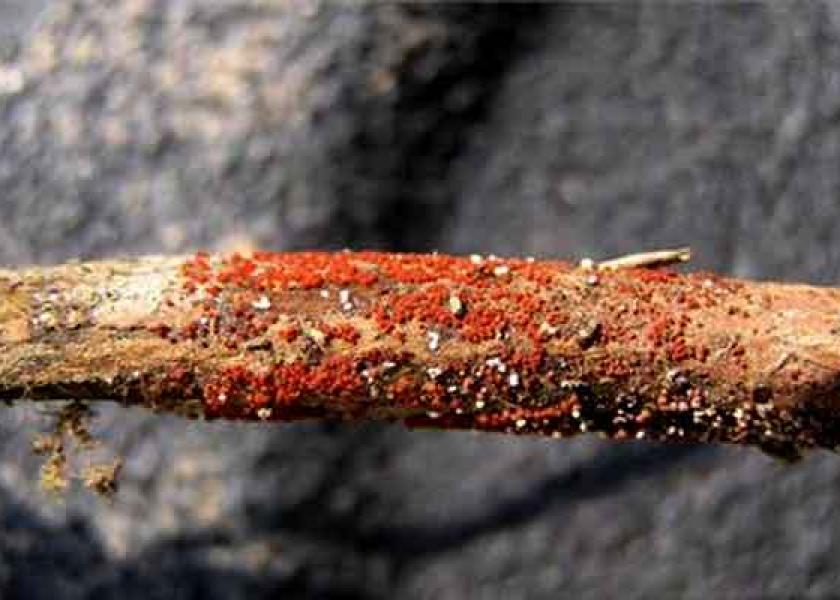Red Crown Rot Reaches Illinois Soybean Fields, Suspected in Other Midwestern States

A disease first identified in southern soybean fields in 1972 has made its way into Illinois. Called red crown rot, it can appear at a glance to be one of several other more common Midwest soybean diseases, says Abigail Peterson, director of agronomy for the Illinois Soybean Association.
“It mimics the foliar appearance of sudden death syndrome (SDS) and some other diseases,” she says. “It’s one of those diseases that you have to look closely at in the field to identify.”
The Crop Protection Network, a collaboration between land grant universities, public and private agronomic specialists across the U.S. and Canada, says the foliar symptoms can be confused with other diseases as well. Those include brown stem rot, or southern stem canker. Stem symptoms can look like other stem diseases, as well, including charcoal rot, Rhizoctonia root rot, and Phytophthora stem rot.
Caused by the soilborne fungus Calonectria ilicicola, red crown rot (RCR) was confirmed in Pike County, Ill., in 2019.
Field surveys done in 2020 and 2021 by Whitney Welker, a graduate student at the University of Illinois, confirmed 14 Illinois counties had fields with RCR. They include Bureau, Christian, Effingham, Fayette, Ford, Kankakee, Livingston, Madison, Marion, Pike, Tazewell, Sangamon, St. Clair and Woodford.

In September 2021, RCR was also confirmed in Kentucky soybeans.
While Extension agronomists have scouted for RCR in Iowa, Indiana and Wisconsin soybean crops it has not been confirmed in those states, to date.
Red, Fruiting Structures
Visual symptoms of red crown rot often show up in soybeans between R3 and R7 growth stages. The foliar symptoms of RCR - interveinal chlorosis and necrosis - are nearly identical to SDS, according to Clint Gregory, an agronomist with Hutson, Inc., Mayfield, Ky. He recommends two additional tips for identifying RCR.
First, he says to check whether the leaves of a soybean plant stay attached to the petioles instead of dropping off as they commonly do with SDS. A second, more defining symptom of RCR is to observe the base of the plant stem just above and just below the soil line. Look for small, red fruiting structures at the base of the plant, Gregory says. These are called perithesia and are very symptomatic of the disease.
Welker says if the disease severity is high, soybean plants often start defoliating prematurely. Her research the past two years shows that the fungus causing RCR also causes pre- and post-emergence damping off in soybean as well as root rot and foliar chlorosis and necrosis after flowering. Infected plants die prematurely reducing seed production.
Double-digit yield losses in Illinois soybean fields have been recorded. Losses of 25% are common in southern soybean fields, according to Nathan Kleczewski, a former University of Illinois Extension field crop pathologist who’s now with Growmark.
He says how the disease moved into the Midwest has not been confirmed but could have been caused by some combination of machinery, wildlife and flooding.
No Good Control Options
Peterson says there are no effective rescue treatments for RCR once the infection has moved into a field. “Applying a fungicide won’t take care of the disease,” she says.
Instead, farmers must address the disease through management and cultural practices, according to the Crop Protection Network. And, for farmers who like to plant early soybeans, the practices are not necessarily a positive.
“Delaying planting may result in unfavorable soil temperatures for root infection,” the Network reports, noting the disease likes wet, cool conditions. Poorly drained soils and soils with high clay content may also increase disease severity.
“Crop rotation out of soybean for at least two years can reduce the disease-causing inoculum," the Network adds. "Improving draining in areas where pooling is problematic, avoiding excessive organic matter in soils, and managing pathogenic nematodes and root feeding insects can help reduce red crown rot issues.”
New Study Shows Glyphosate Ban Would Drive Up Food Prices
Got Skip Row Corn? Georgia Farmer Goes 60" Wide







